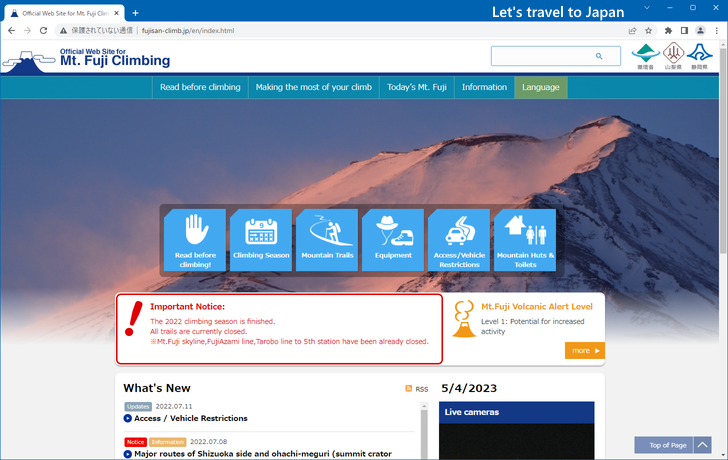Highlights and access methods of Mount Fuji (Shizuoka Prefecture)
In this article, we will explain the attractions of Mount Fuji in Shizuoka Prefecture and how to access it for those who are traveling to Japan from overseas.
(Last modified: )
(Prefecture : Shizuoka , Category : Nature and Scenic Spots)
Table of contents
About Mount Fuji
Mount Fuji, standing at 3,776.24 meters (12,389.2 feet), is the tallest and most iconic mountain in Japan. It is a dormant stratovolcano, which last erupted in 1707-1708, and is located on the border of Shizuoka and Yamanashi prefectures. Revered as a sacred site, Mount Fuji has been a popular pilgrimage destination for centuries and has inspired countless works of art and literature.
Designated as a UNESCO World Heritage Site in 2013, Mount Fuji is not only a symbol of Japan but also an important cultural and spiritual landmark. Its nearly perfect symmetrical cone shape makes it a popular subject for photographs and paintings. The mountain is open for climbing during the official climbing season, which typically lasts from July to early September. Visitors from around the world come to climb Mount Fuji, enjoy the breathtaking views, and experience the unique natural beauty it offers.
Highlights of Mount Fuji
Mount Fuji, or Fujisan, is Japan's highest and most iconic mountain, standing at 12,389 feet (3,776 meters) tall. It is located on the border between Yamanashi and Shizuoka prefectures, and its nearly perfect symmetrical cone shape has inspired artists, poets, and travelers for centuries. Recognized as a UNESCO World Heritage Site, Mount Fuji is an essential destination for international tourists visiting Japan.
As an active stratovolcano, Mount Fuji is not only a popular destination for sightseeing, but it is also a well-known spot for mountain climbing. Many people embark on the pilgrimage to the summit, either as a spiritual journey or as an adventurous challenge. There are four main climbing routes, with the Yoshida Trail being the most popular among climbers. The mountain huts along the routes provide accommodation and respite for weary hikers.
The official climbing season for Mount Fuji is from early July to early September, as this period offers the most favorable weather conditions. During this time, hikers can expect warmer temperatures and a lower likelihood of encountering snow. Keep in mind that the mountain can be quite crowded during weekends and holidays in the climbing season, so plan accordingly.
If you prefer to admire the beauty of Mount Fuji from a distance, there are several nearby locations that provide stunning views of the mountain. The Fuji Five Lakes region, including Lake Kawaguchiko, offers fantastic opportunities to photograph and appreciate the majestic mountain, especially during the cherry blossom season in spring or the vibrant autumn foliage.
In conclusion, Mount Fuji is an awe-inspiring destination that captures the hearts of international tourists with its natural beauty, cultural significance, and countless opportunities for adventure. Whether you choose to climb the mountain or admire its beauty from afar, visiting Mount Fuji is an unforgettable experience that should not be missed.
Address and access method of Mount Fuji
Mount Fuji does not have a specific address as it is a large, natural landmark spanning across both Shizuoka and Yamanashi Prefectures. The closest stations to Mount Fuji differ depending on which side or trail you plan to visit.
For the Fujinomiya Trail in Shizuoka Prefecture, the nearest station is Fujinomiya Station, accessible via the JR Minobu Line. From there, you can take a bus to the Fujinomiya 5th Station.
For the Yoshida Trail in Yamanashi Prefecture, the nearest station is Kawaguchiko Station on the Fujikyuko Line. From the station, buses are available to transport you to the Fuji Subaru Line 5th Station.
In both cases, it is important to check bus schedules and availability, as they may vary depending on the season and weather conditions.
Attractions near Mount Fuji
Near Mount Fuji, there are several other attractions you can visit:
Fuji Five Lakes
A group of five lakes located at the northern base of Mount Fuji, offering breathtaking views of the mountain. The lakes are Kawaguchiko, Saiko, Yamanakako, Shojiko, and Motosuko.
Oshino Hakkai
A small village with eight picturesque ponds fed by the snowmelt from Mount Fuji. The clear waters and traditional thatched-roof houses create a serene atmosphere.
Arakurayama Sengen Park
Home to the iconic Chureito Pagoda, this park offers stunning views of Mount Fuji, especially during cherry blossom season.
Hakone
A popular hot spring resort town with beautiful scenery, including Lake Ashi, and numerous traditional inns (ryokan) where you can experience Japanese hospitality.
Gotemba Premium Outlets
A large shopping mall located at the base of Mount Fuji, offering a wide range of international and Japanese brands at discounted prices.
Aokigahara Forest
Also known as the Sea of Trees, this dense forest at the northwest base of Mount Fuji offers unique trekking experiences and the opportunity to explore lava caves.
Fujikawaguchiko Onsen
A hot spring town near Lake Kawaguchi, where you can relax and enjoy traditional Japanese bathhouses with views of Mount Fuji.
Other information about Mount Fuji
Official site (English version) about Mount Fuji :
http://www.fujisan-climb.jp/en/index.html

-- --
Thank you for reading to the end.
( Written by Tatsuo Ikura )